
|
AN EARLY 20TH CENTURY VARIABLE RADIO COIL BY MUIRHEAD & CO. LTD, WESTMINSTER
constructed in wood and Bakelite, the top with rotary stud switch, for 1-20 megahertz or millihenries, signed on the top as per title, with company label attached - 11in. (28cm.) high; together with an artificial aurora, unsigned, with 22in. electrostatic glass vacuum tube with brass mounts and contacts, thread mounted to substantial brass bedplate with air inlets and tap, on cast iron foot - 30in. (76cm.) high (overall); together with a Megger insulation and continuity tester, series 2 by Evershed & Vignols Ltd, London, mounted on a wooden base with maker's label and Perspex and metal cover and a high voltage generator demonstrator by Cox-Cavendish Electrical Co., London, circa 1920
(4)
£100-150
|
|

|
Ø AN EARLY 19TH CENTURY MARINE BAROMETER BY J.R. & H. STEBBING, SOUTHAMPTON
with inset ivory scale signed and per title and 63 High Street, enclosed by door with mercury thermometer, plain mahogany shaft with lacquered brass weight and reservoir and gimbal - 38in. (96cm.) high
£700-900
|
|

|
A LATE 19TH CENTURY MARINE STICK BAROMETER BY NEGRETTI & ZAMBRA, LONDON
constructed in brass, the enamelled dial signed as per title with weather readings in red and black on left side, marked M.O. No. 187 to top, front mounted thermometer and weighted foot - 36in. (91.5cm.) high
£400-600
|
|

|
A POCKET BAROMETER BY ASPREY, LONDON, CIRCA 1920
with 2¼in. silvered dial signed as per title and readable to 8000 feet, curved bar thermometer complete with mercury, blued steel indicator, contained within crocodile case with silver hinge hallmarked for Asprey, London - 3¼in. (8.2cm.) diameter
£200-400
|
|

|
A GERMAN POCKET BAROMETER COMPENDIUM, CIRCA 1900
the scale readable to 2400 meters; the reverse with curve-bar thermometer and compass with jeweled pivot, contained in Morocco leather case - 3in. (7.5cm.) wide
£80-120
|
|

|
AN EARLY 20TH CENTURY MAHOGANY BAROGRAPH FOR H.J. SPIERS
lacquered brass bedplate set with six atmospheres, recorder drum with clockwork motor mounted on base with two compartment chart drawer with brass inlay and bevelled glass cover (base warped) - 10 x 16½in. (25.5 x 42cm.); together with a thermograph circa 1920, unsigned
(2)
£300-500
|
|

|
A RARE LATE 19TH CENTURY COMBINED THERMO-HYGRO-BAROGRAPH, PROBABLY FRENCH
unsigned, the 7½in. recording drum with clockwork motor with triple-pen recording assembly to right recording five-atmosphere pressure drum, coiled thermospring and string-operated humidity components, mounted on a lacquered brass platform with four feet to wooden base with glazed and perforated cover - 13 x 12 x 7in. (33 x 30.5 x 18cm.) overall
£600-800
|
|

|
A LATE 19TH CENTURY PLUVIOGRAPH BY PASTORELLI & RAPKIN LTD, HATTON GARDEN, LONDON
with ivorine maker's plate engraved The "Wilson" Pluviograph, clockwork recording drum, plated brass fittings comprising rainfall indicator acting on magnetic impulse drive to two external wires enclosed by wooden cover with bevelled glass panels - 9½ x 10½ x 11½in. (24 x 26.5 x 29cm.)
£400-600
|
|
|
|
 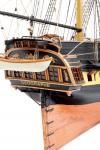 |
A FINELY REALISED 1:48 SCALE FULLY RIGGED STATIC DISPLAY MODEL FOR THE FRENCH ARMED SURVEY CORVETTE GÉOGRAPHE [1794]
modelled by D. Prior, with copper sheathed planked hull ebonised wales and yellow upper works, full length figurehead of a maiden warrior, glazed stern and quarter gallery, chain plates with dead eyes and swing booms, metal anchors with bound wooden stocks, gun ports with several cannons, planked and varnished deck with details including hammock nets, belaying rails with pins, grating capstan, belfry, companionways, well deck with boats in chocks, fire buckets, Venetian red bulwarks, carved wooden helm, compass box, and other details, bound masts with yard, stundt'l boom, standing and running rigging, mounted to wooden cradle stand - 41 x 58 x 17in. (104 x 147.5 x 43cm.)
Launched as Galaéte but renamed Géographe 15 days later, this 385 ton corvette was sent by the French government with consort Naturaliste to survey the coast of Australia in October 1800, whilst there her commander Nicolas Baudin famously conversed the Royal Navy's Matthew Flinders undertaking the same task when the two countries were at war
This model will be available for viewing at Imperial Road
£1800-2500
|
|

|
A ½IN.:1FT. SCALE STATIC DISPLAY MODEL OF H.M.S. INVESTIGATOR [1794]
modelled by D. Prior with planked hull copper sheathing, ebonised wales and yellow buckle works, carved bust-length figurehead of a knight, glazed stern and quarter galleries, chain plates and deadeyes, open gun ports with lids, planked and varnished decks, details including belaying rails, belfry, stove pipe, well deck with fitted boats over, bilge pumps, six carronades in sliders, capstan rigged helm to whipstaff, stern chasers; bound masts with yards, stun's'l booms, standing and running rigging, mounted to cradle stand with brass plates - 31 x 43in. (79 x 109cm.)
H.M.S. Investigator was a 334-ton armed exploration vessel which, under the command of Matthew Flinders, surveyed much of the Australian coast line
This model will be available for viewing at Imperial Road
£1500-2000
|
|

|
AN INTERESTING 1:24 SCALE FULLY-RIGGED STATIC DISPLAY MODEL OF THE ARMED SURVEY SUPPORT SHIP LADY NELSON [1799]
modelled by D. Prior from his own researched after a similar model held at the Maritime Museum, Greenwich, the carved hull finished with simulated copper sheathing below the waterline, ebonised and yellow wales, planked and varnish desks, chain plates with dead eyes, and with details including bound metal anchors with wooden stocks, anchor winch with metal ratchet, three drops keels on windlasses, stove pipe, belaying rail with pins, bilge pumps, glazed saloon lights, six brass cannons on red painted carriages and six swivel guns on rail, tiller, stern lamp and fully fitted ship's boat on stern davits, masts with standing and running rigging as appropriate, masts with stun's'l booms, standing and running rigging, mounted on a cradle stand - overall 35 x 42 x 17in. (89 x 107 x 43cm.); historical notes
This 60-tons vessel accompanied Matthew Flinder's Investigator in 1801-03. She was wrecked in July 1895 by pirates off Babar Island, East Timor
This model will be available for viewing at Imperial Road
£1000-1500
|
|

|
A DETAILED AND WELL-PRESENTED WATERLINE MODEL OF H.M. SCHOONER ENTREPRENANTE AS DEPICTED AS SERVING AT TRAFALGAR
the 8in. planked hull with scored decks fitted with carronade and details including anchor winch, gratings belaying rails and pins, bilge pumps, deck light, companion ways, compass box, tiller, fitted boat in stern davits, 12 carronades in sliders with shot racks and animated crew, mast with yard standing and running rigging and full set of lined paper sails with reefing points, depicting sailing briskly in a green moulded sea in glazed wooded case with name plate - 12 x 16 x 8½in. (30.5 x 41 x 21.5cm.)
The armed cutter Entreprenante was built in France and operated as a privateer until 1799 when she was captured and assimilated into the British Royal Navy under her original name. Measured at 123 tons, she was 67 feet in length with a 22 foot beam and mounted 10-4pounder guns. By 1805, she was under the command of Lieutenant Robert Young and had been re-armed with 10-12pounders. Accompanying Nelson's fleet in the run-up to Trafalgar, her speed and manoeuvrability ensured she was kept busy carrying orders and dispatches between the ships and stations. Like her contemporary Pickle, she kept clear of the fleet action but nevertheless picked up the survivors of the French '74' Achille when she blew up, and she was almost selected to carry back Collingwood's Trafalgar Dispatch. In December 1810 when, whilst cruising off the Spanish Costa del Sol, she was attacked by four well-armed French privateer galleys. Surviving a furious fight lasting three hours incredibly she saw off her attackers and left them all badly damaged. Severely mauled herself, she limped home to England and was broken up in 1812
£600-800
|
|

|
A SAILOR'S SHIP MODEL OF A PACKET SHIP, CIRCA 1820
the carved and painted hull copper sheathed below the waterline and painted black and white with simulated gun ports, plain deck with simple fittings and stacked suite of ship's boats with two more in davits, helm and stern cabins, masts and yards with rigging and blocks, mounted on a cradle stand secured within glazed wooden case with white back board. Overall measurements - 27 x 34 x 15in. (68.5 x 86.5 x 38cm.)
This model will be available for viewing at Imperial Road
£400-600
|
|

|
A FINELY RESTORED LATE 19TH CENTURY MODEL OF THE NEWCASTLE COLLIER THOMAS AND ANN
with planked and pinned mahogany hull, finished in dark brown to the chain plates with red boot top, gold filigree decoration to stern and scroll-form headpiece, the deck planked and pinned with trenails and with fittings including oxidised-brass anchors with bound wooden stocks attached to stayed chain, rope around working windlass with ratchet, bitts, belaying rails and pins, planked and fitted ship's boat in chocks with oars and rudder, covered hatches, sail winches, bilge pump, companionway, saloon light, eight-spoke wooden helm, masts with standing and running rigging, with deadeyes and blocks, yards with foot ropes, and full suit of stitched linen furled sails and other details, secured to a cradle stand - overall measurements 33 x 45 x 15in. (84 x 114.3 x 38cm.)
This model will be available for viewing at Imperial Road
£800-1000
The following seven models were all made by renowned miniaturist John Evans. Winner of several Gold Medals from various exhibitions, the attention to detail and presentation is of a standard rarely achieved at such fine scales.
|
|

|
A 1:200 SCALE MODEL OF H.M.S. VICTORY CIRCA 1805
modelled by J. Evans with 2in. carved and painted hull, wooden decks with some fittings including belfry, example gun batteries, saloon light and stern lamps, bound masts with yards, standing and running rigging, mounted in glazed display case with legend, overall measurements - 4¼ x 5¼ x 2¾in. (11 x 13.5 x 7cm.)
£150-250
|
|

|
A 1:384 SCALE MODEL OF SANTA MARIA
modelled by J. Evans with a carved and planked hull and deck with some fittings including a sample gun and fitted boat, three masts with standing and running rigging, full suit of lined paper sails painted with red crosses as appropriate and other details, mounted in glazed case with legend - 5½ x 7 x 4in. (14 x 18 x 10cm.)
£100-150
|
|
  |
A FINELY REALISED 1:600 SCALE DIORAMA OF THE PADDLE TUG ANGLIA TOWING CLEOPATRA TOWARDS LONDON IN 1878
modelled by J. Evans from his own researches, each complete with intricately detailed fittings and depicted in a brisk green sea set within a glazed wooden case with plaque, overall measurements - 4½ x 12¾ x 4¾in. (11.5 x 32.5 x 12cm.)
In 1801 the Khedive of Egypt, Mehmet Ali, offered Great Britain, France and America each one of the three stone obelisks lying at Alexandria popularly (but incorrectly) known as "Cleopatra's Needles". Weighing about 240 tons, the French and the Americans moved theirs with comparative ease, however the British - whose Navy had refused to be involved - developed a complicated, somewhat eccentric, method. John Dixon (an engineer) designed a cylindrical hull comprising a straight stem, bilge keels, balancing sails, rudder and six man deck house to be taken out to Egypt in sections and assembled around the needle and which would then be towed back to England. All proceeded to plan and the curious craft now called Cleopatra departed on 21st September 1877 under tow from the 1300 ton passenger/cargo ship Olga. On October 14th they encountered a force 12 storm and six of Olga's crew were lost trying to rescue the crew of Cleopatra which they were finally forced to cast off. Cleopatra drifted in the Bay of Biscay for four days until salvaged by the S.S. Fitzmaurice whose master extracted a salvage of £2000 for his troubles. Finally recovered and repaired, the William Watkins Ltd paddle tug Anglia was chartered to bring the Cleopatra home which was happily accomplished without further incident. Arriving at Gravesend on 21st January, 1878, the needle has stood on Victoria embankment ever since, together with a bronze plaque commemorating the lives of those lost in her extraordinary passage.
£400-600
|
|

|
A FINELY DETAILED AND MODELLED 1:384 SCALE 12-GUN BRIG OF WAR, CIRCA 1840
modelled by J. Evans with 3½in. carved hull plated below the waterline and planked above the wale, gilt head piece, chain plates with deadeyes, cathead with anchors, planked decks with fittings including gratings, bitts with coiled rope, companionways, guns rigged in carriages, fitted boats stacked between masts, bilge pump, capstan, helm rigged to whip-staff, stern houses, fitted ships boat with oars in stern davits, twin masts with standing and running rigging and other details, mounted within glazed display case with plate. Overall measurements - 7¼ x 8 x 4¼in. (18.5 x 20.3 x 11cm.)
£400-600
|
|

|
A FINELY DETAILED 32FT. TO 1IN. SCALE WATERLINE MODEL OF THE ROYAL YACHT BRITANNIA AS DELIVERED TO H.M QUEEN ELIZABETH II IN SPRING 1954
modelled by J. Evans, the carved and plated 12in. hull with lined decks, superstructure fully fitted and detailed as appropriate, three finely rigged masts with flags and pennants flying, depicted at anchor in a calm green sea with lowered boarding companionway with motor launch in attendance, glazed display case with plaque. Overall measurements - 6¾ x 15¼ x 8¼in. (17 x 38.5 x 21cm.)
Built by John Brown & Co. to replace the ageing Victoria & Albert III which had served the Royal family since 1901, her hull was riveted internally bestowing her with the famous mirror-like shimmer upon the water. During her forty-three years of service, Britannia, powered by steam turbines, steamed over a million nautical miles and was the setting for many a diplomatic coup as heads of state clamored for an invitation to dine in the magnificent banqueting salon - it was generally acknowledged that she effectively earned the UK over £3billion a year with business won aboard on these cruises. Her final poignant act was her sun-set departure from Hong Kong in 1997 with Prince Charles accompanied by the last Governor, Chris Paton, ending rule in the last significant British colony. Age had finally caught up with her and, in need of an expensive refit, the newly elected Labour Government of 1997 decided to delete her from the Naval List and cancel the replacement announced by the previous administration. Thus ended a hitherto unbroken 337 year tradition of continuous Royal Yachts with no apparent reversal in sight and Britannia herself a popular tourist attraction in the Edinburgh suburb of Leith
£1500-2500
|
|

|
A FINELY DETAILED 1:384 SCALE MODEL OF THE TEA CLIPPER THERMOPYLÆ
modelled by J. Evans with carved hull plated below the waterline and planked above, lowered boarding companionway and figurehead, planked decks with fittings including deck rails, bitts, catheads, capstan, stove pipe, covered hatches, deck houses with boats secured over, bilge pump, fitted boats in racks, saloon lights, compass, helm, white masts and yards with standing and running rigging with blocks, tackle and flags, and other details, mounted in glazed case with plate. Overall measurements - 8¼ x 12 x 5in. (21 x 30.5 x 12.5cm.)
Thermopylæ was built in Walter Hood's yards in Aberdeen in 1868, to the order of George Thompson & Co. of London. A splendid sea boat, she was fast in any weather and especially quick at going to windward. Launched on 19th August 1868, she sailed from Gravesend on her maiden voyage to Melbourne on 7th November the same year and anchored in Port Phillip after a record run of 60 days (pilot to pilot). Continuing to make extremely fast passages throughout the 1870s, she loaded her final tea cargo at Foochow in 1881 before being transferred to the Australian wool route. During the 1880s, she frequently raced her old tea-trade rival Cutty Sark from Sydney to London, via Cape Horn with a best passage of 76 days in 1882. In 1890 Thermopylæ was sold to Canadian owners for £5,000 and from 1892 to 1895 she was used in the trans-Pacific trade. In 1896 she was resold to the Portuguese Government, renamed Pedro Nunes, and put to work as a cadet training ship. Her condition deteriorated gradually and by 1907 her working life was over. On 13th October that year, she was towed out of the Tagus into the open sea and sunk by gunfire; it was a sad end for such a thoroughbred, but she was - and has remained - one of the legends of the age of sail
£800-1200
|
|

|
A FINE 32FT:1IN. MINIATURE MODEL OF THE CONFEDERATE RAIDER ALABAMA [1862]
modelled by J. Evans with carved and planked 6½in. hull and decks, plated below the waterline, detailed fittings and armament as appropriate, five fully-fitted ships boats in davits, retractable funnel, masts with standing and running rigging flying the Confederate flag from the mizzen gaff. mounted on brass columns within glazed display case with plaque, measurements overall - 7 x 10¾ x 5in. (17.8 x 27.5 x 12.5cm.)
Built and launched by Laird's of Birkinhead in July 1862 as the Enrica to evade Union spies, she was classed as a wooden corvette of 1,050 tons and, on the brink of being seized by the British Government, her final sea trial became her first mission. Renamed Alabama at sea she mounted 6-32pdrs and a single, massive, rifled 100pdr. Manned by 145 officers and men she was capable of an impressive 13 knots under steam. Her reign of terror lasted until June 1864 by when she had captured or sunk sixty-seven Union ships valued at nearly $6 million. Refitting and supplying herself from plunder, she was finally forced, leaking and fouled, into Cherbourg for repairs. Here she was cornered by the superior U.S.S. Kearsage which, on the 19th June, forced her into the English Channel. Once free of the 3-mile limit a furious but unequal circling action commenced which had but one outcome. The raider struck her colours but sank before she could be taken and immediately assumed the status of legend in her own lifetime, as well as in the years that followed the bitter defeat of the Confederate Southern States of America.
£1200-1800
Other Properties
|
|
   |
A FINELY MADE 1:48 SCALE BUILDER'S-STYLE MODEL OF THE 'GADFLY' CLASS FLATIRON GUNBOAT H.M.S. GRIPER [1879]
modelled by G. Cheikhet from his own detailed researches the bespoke fibreglass hull with planked deck and bulwarks, gold-plated armament and fittings including decorated bow and stern, anchors on brackets, a finely-realised 10in. muzzle-loading rifled Armstrong gun mounted in bow, deck rings, winches, coal shute covers, deck lights, capstan, ventilators, helm with heat shield, bilge pump, funnel with whistle, engine room light surrounded by shell cases, companionways, water casks and other details, mounted on two turned gilt pedestals within glazed wooden case, the model - 13 x 31in. (33 x 79cm.)
Originally developed as coastal defence vessels, flatirons were unusual for the time in having no rigged 'back-up' to their coal-fired engines. Somewhat ungainly in appearance, their sole armament was a single 10in. muzzle-loading rifled gun by Armstrong located in the bow. Whilst they were slow, cumbersome, and not considered a great success, about thirty were made over three decades and they generally ended up in harbour service or as tenders. Griper was one of four in this class built by Pembroke Dockyard, displaced 254 tons, measured 85ft x 26ft and her 2 cylinder reciprocating engine pushed her along at a stately 8½ knots. Sold in 1923 she was renamed Flora before changing hands - and continents in 1933, and spent her remaining years as Afrikander, being broken up at Cape Town in 1951
£3000-4000
|
|

|
A WELL PRESENTED AND DETAILED 1:192 SCALE WATERLINE MODEL OF THE 'FLOWER' CLASS CORVETTE H.M.S. CAMPANULA AS FITTED IN 1942
modelled by John R. Haynes with a bespoke pre-formed dazzle-finished hull with pennant number 'K18' to bow and stern, lined and painted decks and superstructure complete with fittings and armament as appropriate, set in a moulded and painted seascape with brass detail plaque on display base with glazed wooden cover. Measurements overall - 5½ x 17¼ x 4½in. (14 x 44 x 11.5cm.)
As the threat of War with Germany became ever more likely the Royal Navy urgently needed a class of escort vessels to counter the U-boats they knew would harry convoys. In the end 145 'Flower Class' corvettes were built by various Allied yards between 1939-45, displacing less than 1000 tons, each was lightly armed with a single 4in. gun (and four machine guns) and depth charges in twin racks. Campanula was built by Fleming & Fergusson Ltd, Paisley, was commissioned in May 1940, and she saved many lives from torpedoed merchantmen during the hostilities. Her most famous officer was the successful and prolific author Nicholas Monserrat R.N.V.R. (1910-79) who recalled his time aboard in his novel The Cruel Sea in which Campanula became H.M.S. Compass Rose. Campanula was broken up in 1947
£1000-1500
|
|

|
A 1/24IN:1FT SCALE WATERLINE MODEL OF CUNARDS R.M.S. SERVIA [1881]
modelled by M. Fidgeon with laminated and carved hull, fitted as appropriate complete with barque rig and depicted steaming in a calm sea - 12½ x 28½ x 8in. (31.5 x 72.5 x 20cm.) cased
Built by J.&G. Thomson in 1881 and registered at 7,392 tons, Servia introduced a number of 'firsts' to the Atlantic passenger trade making her the first truly 'modern' liner: The first ship built to specialise in passengers only; the first Cunarder to introduce Edison's electric lamps; the first major liner to be built entirely of steel and to re-introduce Brunel's double bottom; and to incorporate watertight compartments with electric doors enabling her to remain afloat with any two flooded. Her public rooms were of a scale and luxury unknown at the time, and her powerful 10,300 ihp engines achieved an impressive speed of just over 17 knots. However, with the appearance of the crack Cunard liners Campania and Lucania in 1893, Servia was relegated to intermediate service. She was later used to transport troops to South Africa during the Boer war and was broken up in 1902 by Thos W. Ward
£400-600
|
|

|
A 1:40 SCALE HALF-BLOCK MODEL OF THE PILOT CUTTER JOLIE BRISE [1913]
modelled by P. Ward with carved hull finished in black and red with varnished deck fittings, cutaway mat and bow sprit, mounted in wooded display board with brass name plate - 18½ x 26¾in. (22 x 68cm.)
£150-250
|
|

|
A 1:24 SCALE HALF-MODEL OF A SPIRIT 46 CLASSIC
modelled by P. Ward with varnished desk and cutaway mast, finished in red and grey, mounted on a wooded display board with brass plate - 8½ x 26¾in. (21.5 x 68cm.)
£150-250
|
|

|
A 1:24 SCALE HALF-MODEL OF A NICHOLSON 40 AC [1979]
modelled by P. Ward with cutaway mast and painted fittings, mounted on a wooded display board with brass plate - 10 x 24in. (25.5 x 61cm.)
£150-250
|
|

|
AN ATTRACTIVELY PRESENTED 19TH CENTURY WATERLINE MODEL OF A TWO-MASTED YACHT
the hull carved from the solid with billet head and dolphin striker, gratings, winch, companionway, boat in davit and tiller, raked masts with full suit of paper sails, standing and running rigging, spreaders and painted flags, set in a green painted sea within arched glazed wooden case with rope work moulding around lower edge. Overall measurements - 17½ x 22 x 11½in. (44.5 x 56 x 29cm.)
£300-500
|
|

|
A ¼IN.:1FT SCALE MODEL OF A SHETLAND SIXERN OLD TIMES [1930]
modelled by R. Phillip as in working practice in fruitwood, the clinker-built hull finished in white and blue, fitted with cross boards, ports with a collapsible mast and rudder, mounted on wooden pedestal to display base with carved oars and name plate - 9½ x 9½in. (24 x 24cm.)
£200-300
|
|

|
A BERMUDAN RIGGED BAR-KEEL POND YACHT GAWD. L. PUSS
built by A.J. Taylor with carvel hull, contrasting wood deck screwed to frame, plate to stern inscribed Gawd. L. Puss / London, cockpit with slats and benches, brass tiller yoke rigged to rudder, square section mast with wire rigging, spreader and stitched linen sail with baton pouches, the main sail numbered 68, loosely mounted on a cradle stand - 75 x 37in. (190.5 x 94cm.); together with detached maker's plate Built by A.J. Taylor 1971/72
This model will be available for viewing at Imperial Road
£400-600
|
|
  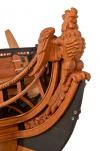  |
A FINELY CRAFTED AND IMPRESSIVE 1/16IN.:1FT SCALE ADMIRALTY-STYLE MODEL OF THE ROYAL FRENCH NAVY'S 50-GUN 3RD RANK SHIP LE FRANÇOIS [1691]
modelled as in authentic practice in pear and black hornbeam by Y. Vladimirovich to 17th Century drawings by François Colom adapted by Jean Claude Le Mineur, the fully-framed hull pierced with gunports and finely carved cockerel figurehead supported by pierced scrolls, carved cathead supports, gratings, anchors with wooden stocks, moulded top-deck guns in carriages with Royal Arms, fully-fitted ship's boat with cross boards, thwarts and oars lashed to chock mounts, ebonised capstan, belfry, poop deck with livestock cage, stern cabins and quarter lights, mounted on wooden cradles on green baise-lined case with wood-bound plexi-glass cover and name plates. Cased measurements - 32 x 96 x 25in. (81.5 x 244 x 63.5cm.)
£20000-30000
Le François was designed and built by Étienne Salicon at Le Havre between 1687-88. She measured 125½ft x 33ft x 15ft (in French units of measurements - the pre-metric French pieds equalling 32.484 cm., so 6.575% greater than British feet). She was manned by 280 men plus six officers and was initially rated as a 4th Rank ship of 40 guns but was raised to the 3rd Rank from 1691 with 50 guns, being pierced for eleven pairs of lower deck guns and twelve pairs of upper deck guns. She remained at this Rank until c.1713 when she was reduced to 4th Rank again. The François took part in the Battles of Bantry Bay (11th May 1689) and Beachy Head (10th July 1690). From 1694 to 1695 she was one of a number of the King's ships 'lent' to René Duguay-Trouin for privateering under the armament mixte arrangements whereby Louis XIV participated financially in privateering ventures using French naval vessels. In Duguay-Trouin's hands she took part in the capture of H.M.S. Nonsuch (40) and H.M.S. Boston (32) on 4 January 1695. She was 'lent' again between 1695-96 for another armament mixte arrangement (this time under the Marquis de Nesmond), and took part in the capture of H.M.S. Hope (70) on 16 April 1695 before being returned to official French naval service where she remained until 1735, being broken at Rochefort in 1736
Charles Miller Ltd is grateful to Rif Winfield for his assistance with this lot.
Literature: Winfield, R. & Roberts, S.: French Warships in the Age of Sail 1626-1786, Seaforth Publishing
This model will be available for viewing at Imperial Road
|
|
  |
AN ATTRACTIVE EARLY 19TH CENTURY NAPOLEONIC BONE PRISONER-OF-WAR SHIP MODEL OF THE TÉMÉRAIRE
the 5in. hull carved from a section of shin bone, gun ports with guns, carved billet head and stern, chain plates with deadeyes, metal anchors, deck with some fittings including gratings, companionways, guns in trucks, masts with standing and running rigging, blocks and tackle, mounted on straw work base with bone plate inscribed TÉMÉRAIRE within front-glazed straw work case with mirrored back, bone finials and brass drop handle - 9 x 10¾in. (23 x 27.5cm.)
£2500-4000
|
|

|
AN EARLY 19TH CENTURY NAPOLEONIC PRISONER-OF-WAR WOOD AND COPPER MODEL FOR A 74-GUN SHIP
partially assembled, the 6in. hull copper sheathed below the waterline, gun ports with lids and guns, figurehead, scored decks with guns, ship's boats and gratings, secured to contrasting wood stand -7¾in. (20cm.) overall; together with a quantity of loose parts including lined quarter lights; masts; yards; some fittings and rigging.
(A lot)
£150-250
|
|

|
AN ADMIRALTY ROUNDED STERN MODEL FOR H.M.S. DUKE OF WELLINGTON, 1852
carved and hollowed from the solid with deck and back board, finished in polychrome, the port side revealing the frames and starboard as completed with galleries with pierced railings, 'glazed' windows, waste pipe and rudder top - 9¼ x 9 x 9½in. (23.5 x 22.8 x 24cm.)
£500-800
Built at Pembroke Dock and converted for screw propulsion whilst still on the stocks, she was launched on 14th September 1852, the day of the Duke of Wellington's death, and thus renamed in his honour two weeks later. A splendid 1st Rate measured at 3,759 tons (5,829 tons displacement), she was 240 feet in length with a 60 foot beam and 131 mounted guns of varying calibre, including 30-8in. on her gundeck and 30-32 pdrs on each of her other two decks and incorporated the new-but-unpopular rounded stern represented by this model. For her auxiliary power, she was fitted with a 700nhp. engine by Napier - removed from the iron-screw frigate Simoom when she was converted into a troopship in April 1852 - which, on her trials in April 1853, gave her a very satisfactory cruising speed of 10.15 knots
Sent to the Baltic as flagship to Admiral Sir Charles Napier's fleet for the campaign against the Russians in 1854-55, she was widely admired both for her sailing as well as her steaming qualities, although her sea-going career proved a short one, apparently, due to the age of her secondhand machinery and the indecent haste of her conversion to steam as she approached completion. After a brief spell in the Mediterranean as Second Flagship in 1856, she came home to be paid off and was then placed in reserve until 1863 when she became a receiving ship at Portsmouth. This last role proved a lengthy one and, for nearly forty years, she remained a familiar sight at her permanent mooring in the harbour there until she was sold in 1902 and finally broken up in 1909
Charles Miller Ltd is grateful to Prof. Andrew Lambert, Kings College London, for his assistance with this lot.
|
|

|
A 15FT:1IN. SCALE FRAME MODEL FOR THE 120-GUN FIRST RATE MODIFIED 'CALEDONIA' CLASS SHIP H.M.S. ROYAL GEORGE, DESIGNED BY SIR ROBERT SEPPINGS, 1819
with cherry frames pierced with gun ports and pinned boxwood stringing and internal stretchers, mounted at an angle on keel blocks in a finely-realised dockyard slipway with lined boxwood pavements interspersed with sandpaper 'shingle', twin access steps and bitts, within removable glazed wooden cover with turned pilasters and securing hooks. Cased measurements overall - 7¾ x 15¾ x 5¾in. (19.5 x 40 x 14.5cm.)
This new class of ship was the first to introduce Seppings' revolutionary rounded bow - a far stronger and more versatile bow that did away with the delicate and vulnerable head rails traditionally deployed. It meant that more, and heavier, gun types could be carried in an arc around the bow and gave a drier and more rigid passage underway. Latterly the design was extended to include a rounded stern - as seen in lot 285 and, whilst these perhaps represent the apogee of sailing naval design, they were unpopular with their commanders for looking too ugly, despite their many advantages
Charles Miller Ltd is grateful to Prof. Andrew Lambert, Kings College London, for his assistance with this lot.
£4000-6000
|
|
   |
A FINE BUILDER'S HALF-BLOCK MODEL FOR THE S.S. EUPHRATES BUILT BY ALEXANDER STEVEN & SONS, GLASGOW, 1855
carved from 1in. laminated yellow pine with black topsides inscribed Iron Seamer 'Euphrates' No. 9, carved and painted female figurehead, name board with gilt scrollwork, cutaway mast, funnel and bow sprit, mounted on display board with inset builder's plate, inscribed 1855 to lower centre and impressed EX. lower left, overall - 12¾ x 67in. (32.5 x 170cm.)
£1500-2500
|
|

|
A 19TH CENTURY HALF-BLOCK MODEL FOR A SAILING MERCHANTMAN OF CIRCA 1860
carved from ½in. laminated yellow pine with ebonised lined deck, cutaway bow sprit, boxwood stringing, lined fore and aft, lined poop decking mounted on a contrasting wood display board with suspension hooks - 14 x 60½in. (35.5 x 153.5cm.)
£1000-1500
|
|

|
A FINE BUILDER'S HALF-BLOCK MODEL FOR A CUTTER YACHT, CIRCA 1880, PROBABLY BY D. WHYTE
carved from ¾in. laminated wood with contrasting keel and rudder and boot top stringing, mounted on a display board, overall - 8 x 32in. (20 x 81.5cm.)
£600-800
|
|

|
A FINE BUILDER'S HALF-MODEL FOR A STEAM LAUNCH BY D. WHYTE, CIRCA 1880
carved from ⅜in. laminated fruit wood with contrasted wood bulwarks and stringing, propeller shaft and rudder and carved head, mounted on a mahogany display board, impressed each end D. WHYTE - 6½ x 41¾in. (16.5 x 106cm.)
£1500-2500
|
|

|
A GOOD 19TH CENTURY BUILDER'S HALF-MODEL FOR A CUTTER YACHT BY D. WHYTE, CIRCA 1880
carved from laminated ⅛in. contrasting fruit wood with boxwood stringing and yellow pine deck, cutaway bow sprit and mast, mounted on mahogany display board impressed D. WHYTE at each end - 6½ x 29¾in. (16.5 x 75.5cm.)
£800-1200
|
|

|
A GOOD 19TH CENTURY BUILDER'S HALF-BLOCK MODEL FOR A CUTTER BY D. WHYTE, CIRCA 1880
the hull carved from flared ⅛in. to ½in. contrasting fruit wood with boxwood stringing, mounted on mahogany display board impressed D. WHYTE to each end - 6½ x 28in. (16.5 x 71cm.)
£700-900
|
|
   |
A FINE HALF-BLOCK PRIZE MODEL FOR THE 5 TON CUTTER YACHT DORIS, DESIGNED BY G.L. WATSON CIRCA 1885
carved from ½in. laminated wood, finished in cream with black topside, cutaway bowsprit and mast; topsides with glilt lining, mounted on mahogany display board with ivorine plate inscribed Doris 5 Tons presented for competition between Doris and Jess by G.L. Watson, Doris won, pasted G.L. Watson label to reverse Imperial Institute 1897, overall - 11¾ x 40in. (30 x 101.5cm.)
£2500-3500
An interesting example from the final flourishing of the English "Plank on Edge" racing cutter
The rating rules always provided a challenge to the aspiring designer to exploit the constraints in order to produce a prize winning vessel. The Yacht Racing Association decided to revise the current rule because it felt it was encouraging unhealthy development. This new rule, known as the "Tonnage Rule" came into effect in 1882. The decision backfired somewhat, as in the smaller development classes; the 5 and 2½ Tonners, it encouraged extremely narrow, deep keeled vessels, which carried very large sail areas. G.L. Watson, then at the height of his prowess, designed several '5 tonners' to the new rule, commencing with Iris in 1883. In 1885 he was commissioned by R.G. and Bryce Allan, cousins of the Chairman of the Allan Line, to design a new flyer, Doris, which was built at the Govan Shipbuilding Company on the Clyde. With only a 5ft 6in beam on a waterline of just over 38ft, and a draft of 6ft 8in, she proved to be extremely successful, winning the 5 Ton Cup and both Dublin and Royal Northern Regattas in her maiden year. A strong rival of the Allan brothers was Dublin vintner George Black Thomson. He bought the 5 Tonner Olga to challenge in 1885 and then commissioned Luath from the upcoming designer W.E. Paton the following year, but neither could seriously worry Doris. Finally, he commissioned Watson to produce a boat to beat his own. The result was Jess, of similar form although slightly more beam than her rival. They raced together from 1887 and it is recorded that Jess beat Doris twice, although this prize indicates that this was not always the case. Watson himself may have put up the prize. In the 5 Ton class, only Paton's Oona of 1886 exceeded Doris's narrow beam and deep draft, and her loss off Malahide with her designer in the same year, prompted a further revision of the Rating Rules and the days of the "Plank on Edge" were over
|
|

|
AN R.N.L.I. PRESENTATION MODEL FOR THE SAILING AND PULLING MUNDESLEY LIFEBOAT J.H. ELLIOT, CIRCA 1882
of typical form with carved and painted hull bearing R.N.L.I. emblem, grab ropes under wale, bilge keels, hauling holes, rudder with yoke, fitted internally with seats, oars, collapsed mast with ochre-coloured sails, rowlocks, rigging etc, mounted on two gilt brass raised cradle stands and contained within glazed oak display case - 13 x 31 x 11½in. (33 x 79 x 29cm.)
£800-1200
|
|

|
A LARGE QUANTITY OF PERIOD SHIP BUILDER'S MODEL PLATED AND LACQUERED SPARE PARTS AND ACCESSORIES
including lined deck houses, cutaway funnels, ships boats, plated davits, quick firing guns, search lights, assorted propellers, lined decking, winches, ventilators, carved and lined oars, companionways, hatch covers, windows, chain, water casks, blocks and tackle, etc, contained in assorted compartmented boxes
(A lot)
Provenance: The late Martin Brown, former model conservator at the National Maritime Museum, Greenwich
£400-600
|
|
 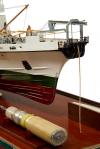 |
AN INTERESTING BUILDER'S MODEL FOR THE M.V. CABLE ENTERPRISE, BUILT BY CAMMELL LAIRD & CO. FOR CABLE & WIRELESS LTD., 1964
the laminated carved hull with ribbed clipper bow, lowered boarding companionway, gilt plated propeller, bow thrusters and rudder, painted decks with fittings including cable drum at bow, double stern, painted decks and fittings, superstructure with over bridge and awning stanchions, communications mast, covered lifeboats in davits, rigged derricks and other details, mounted in glazed wooden display case with detail plates and cable sample - 20 x 54 x 13in. (51 x 137 x 33cm.)
Registered at 4358 tons and measuring over 113 meters with a beam of 15 meters, Cable Enterprise was powered by twin diesel electric motors and was broken up at Alang, India in April 2002
This model will be available for viewing at Imperial Road
£3000-5000
|
|
 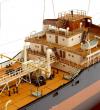  |
A 1:200 SCALE BUILDER'S BOARDROOM MODEL FOR THE TANKER M.V. OILFIELD BUILT BY ODENSE STAALSKIBS DENMARK FOR THE FIELD TANK SS CO., 1938
the laminated and carved hull finished in polychrome with gilt propeller, lacquered lined decks with detailed painted brass fittings, rigged masts with gantry between, aft superstructure with liveried funnel, covered lifeboats in davit's and other details, mounted on two chromed pedestals on display base with engraved chromed builder's plate within glazed wooden cover. Measurements overall - 13 x 36¼ x 8¾in. (33 x 92 x 22cm.)
Completed in February 1938, this 8,516 ton tanker had a short career being torpedoed by U-96 about 350 miles N.N.W. of the Hebrides on 28th April 1941 whilst carrying benzine between Aruba and London. Her Captain (and Fleet Commodore), Laurence Anderson, and forty-six men from a total of fifty-five aboard were killed
This model will be available for viewing at Imperial Road
£2500-3500
|
|
  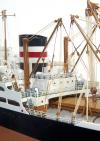 |
A BUILDER'S BOARDROOM MODEL FOR THE M.V. PLAINSMAN BUILT BY DOXFORD FOR THE HARRISON LINE, 1959
the laminated carved hull finished in company livery with lowered boarding companionway and gilt plate propeller, painted decks and hatches, detailed fittings as appropriate including rigged derricks with winches, ventilators, deck rails, anchors with studded chain etc., painted superstructure with covered boats in davits, liveried funnel and other details, mounted on a raised display base with plate within original metal-bound glazed display case - 12¾ x 37 x 11½in. (32.5 x 94 x 29cm.)
Provenance: Bonhams: The Harrison Line Sale, 21st January 2003, Lot 17
This 11,455 ton general purpose cargo ship was rename Evlalia in 1979 and broken up at Aliaga, Turkey in 1985
This model will be available for viewing at Imperial Road
£2500-3500
|
|
  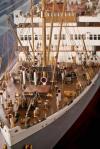 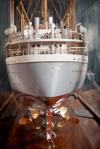 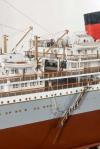  |
A FINE BASSETT-LOWKE BOARDROOM MODEL OF THE R.M.M.V. WINCHESTER CASTLE [1930] AS DEPICTED AFTER HER REFIT IN 1938
the laminated and carved wooden hull finished in red and lavender grey with white topsides, lined lacquered decks crowded with detailed gilt, silvered and painted fittings including winches with studded chains, anchors, bitts, ventilators, wood-capped deck rails, boarding companionways, painted and lined superstructure with covered lifeboats in davits, overbridge with range finder and much other fine detail, mounted on bronzed display columns on display base with maker's plate and specification plate within original glazed case with stand; together with a top lamp, measurements including stand - 68 x 94 x 23½in. (173 x 239 x 59.5cm.)
On view from September 2017 at the DoubleTree by Hilton Hotel, Imperial Road - please see map opposite
£15000-20000
Built in 1930 by Harland & Wolff, Belfast with a length of 656½ft and a gross tonnage in excess of 20,000grt for the Union-Castle Line, the Winchester Castle was the last 'Castle' to be upgraded to oil-fired boilers in 1938 when her twin funnels were replaced with a single raked funnel as seen on this model. During the War she served as a troop carrier but was briefly used as the Allied Headquarters during the invasion of Vichy-held Madagascar as part of Operation Ironclad between May and November 1942. Post war she was deployed as a UK-South Africa migrant ship before being scrapped in Japan in 1960
|
|
  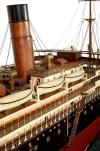 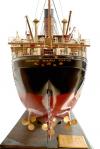  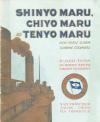  |
A JAPANESE BUILDER'S MODEL FOR THE TRIPLE SCREW TURBINE PASSENGER LINER SHINYO MARU, BUILT BY MITSUBISHI DOCKYARD AND ENGINE WORKS, NAGASAKI, CIRCA 1910 AND BELIEVED TO BE THE ONLY SURVIVING PRE-1945 EXAMPLE
the laminated and carved hull finished in lacquer with bilge keels, rudder, gilt propellers and portholes, lowered and moored companionway, lined decks and hatch covers, with fittings including anchor crane and winch, capstans, ventilators, bitts, rigged derrits, white painted superstructure with bridge with search lamp over, carved and covered lifeboats in davits, stayed funnels, with safety value, extension pipe and funnel, raked masts with standing rigging and ladders, wood capped deck rails, engine room lights, multiple fire buckets, mushroom ventilators, water buckets, emergency helms, telegraphs and binnacle and much other fine detailing, mounted on four turned baluster supports to painted display base with dual ivorine builder's plates in Japanese and English (restoration and some replaced parts) - 44 x 144in. (112 x 366cm.) together with a folder of data and letters from Mitsubishi regarding history etc.; and including a contemporary advertising brochure
(2)
£10000-15000
Provenance: Brussels World's Fair, 1910 (Japanese Pavillion); Museum of Human Knowledge, Brussels, 1910-closure; Private owner-1997; 1997-date Private Collector, Belgium.
This model will be available for viewing at Imperial Road
Launched on the 18th February 1911 with her maiden voyage on August 26th that year, Shinyo Maru was the third and last of a class of crack turbine liners built between 1908-10 for the Toyo Kisen Line which was competing strongly for trans-Pacific traffic against the Pacific Mail Steamship Company and the Occidental and Oriental Steamship Company. Measuring 575ft with a breadth of 63ft. she displaced nearly 22,000 tons and her triple screws gave her a brisk speed of 21 knots. The company went so far as to state in their own literature that The three steamships undoubtedly represent, on the Pacific, the high standard maintained by the "Mauretania" and the "Lusitania" on the Atlantic. Luxuriously appointed throughout to top Western specifications, they were elegantly furnished with Oriental-style Western furniture and decor and could accommodate 210 First; 57 Second and 754 Third Class passengers. Plying a regular route between Hong Kong and San Francisco, in 1926 the Toyo Line was taken over by Nippon Yusen and from 1932 she was laid up, eventually broken up in 1936.
This model is a scarce survivor - modelled in the English style, there are several distinctly Japanese elements - such as the lacquered hull and rudder, and the multiple chain stays applied to the funnels. Having been displayed at the World's Fair in Brussels in 1910, it seems that it was donated to a local museum. As a consequence it survived the atomic bomb that devastated Nagasaki in 1945 and which incinerated every other Mitsubishi model.
| END OF SALE |
|
|

